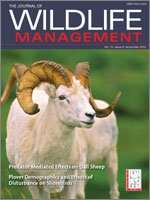The parasitic nematode Trichostrongylus tenuis has a detrimental effect on red grouse (Lagopus lagopus scoticus) at the individual and population levels. Treatment using grit coated with the anthelmintic fenbendazole hydrochloride reduces parasite infection and increases grouse density. However, a frequent and low dose of anthelmintic increases selection pressure for parasite resistance, a serious practical and economic problem. We used an egg hatch assay to test resistance of T. tenuis from 12 moors in northern England, which differed in grit treatment intensity. The anthelmintic concentration that prevented 50% and 95% of T. tenuis eggs from hatching (ED50 and ED95, respectively) did not differ among moors and were not related to treatment. We suggest annual monitoring and responsible anthelmintic use to prevent resistance so that medicated grit continues to enhance red grouse management.
How to translate text using browser tools
1 November 2010
No Evidence for Resistance to Fenbendazole in Trichostrongylus tenuis, a Nematode Parasite of the Red Grouse
Ruth Cox,
David Newborn,
David Baines,
Christopher J. Thomas,
Thomas N. Sherratt
ACCESS THE FULL ARTICLE
It is not available for individual sale.
This article is only available to subscribers.
It is not available for individual sale.
It is not available for individual sale.

Journal of Wildlife Management
Vol. 74 • No. 8
November 2010
Vol. 74 • No. 8
November 2010
Anthelmintic resistance
fenbendazole
medicated grit
nematode
red grouse
Trichostrongylus




